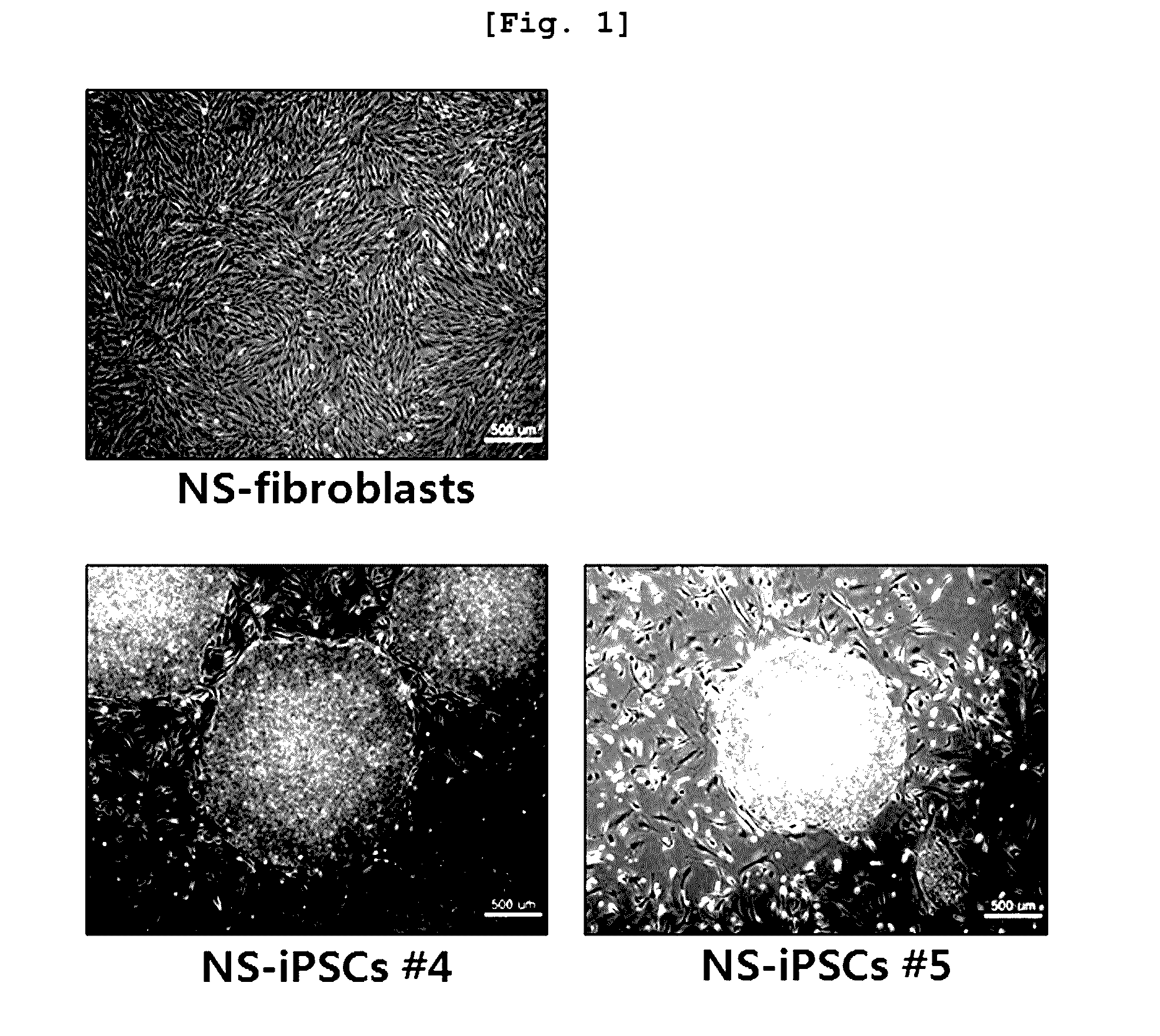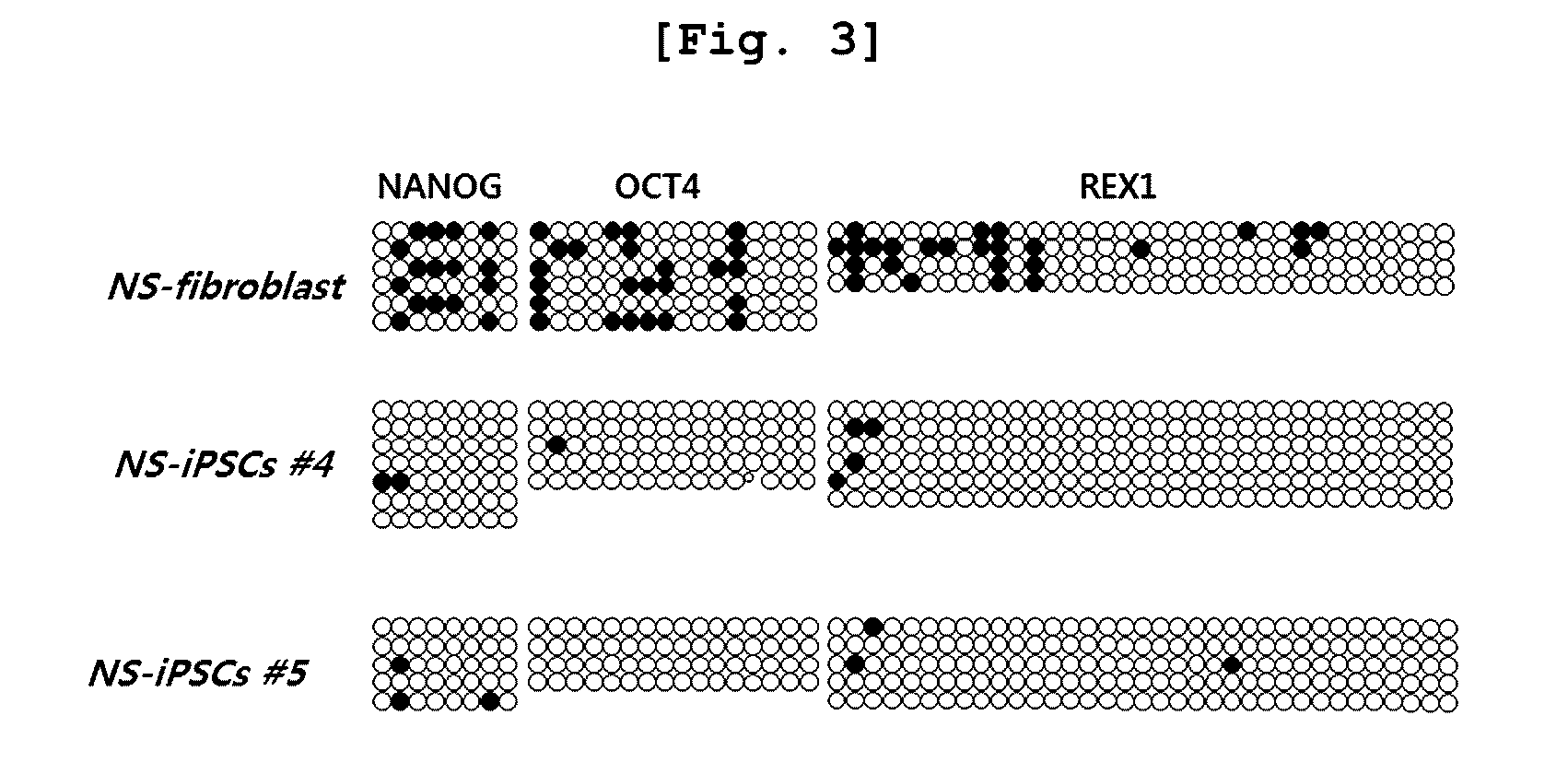Induced pluripotent stem cell model of noonan syndrome and use thereof
a pluripotent stem cell and ipsc technology, applied in the field of ipsc-induced pluripotent stem cell (ipsc) model of noonan syndrome, can solve the problems of insufficient studies on noonan syndrome therapeutic agents or treatment methods, and the development of noonan syndrome has not been disclosed
- Summary
- Abstract
- Description
- Claims
- Application Information
AI Technical Summary
Benefits of technology
Problems solved by technology
Method used
Image
Examples
example 1
Confirmation of Clinical Symptoms and Mutation of the Causing Gene of Noonan Syndrome
Confirmation of Clinical Symptoms of Noonan Syndrome
[0115]To confirm the clinical symptoms of a Noonan syndrome patient, a Noonan syndrome patient was selected and observed clinical symptoms thereof.
[0116]Particularly, a Noonan syndrome patient (B.S.Y, male) was notified by Asan Medical Center (Korea), and the representative Noonan syndrome symptoms were observed as shown in Table 2 (Table 2).
TABLE 2Clinical symptoms of Noonan syndromeFeatureDescriptionFeatureDescriptionFaceTypicalCongenital heart∘shapediseaseNeckShort neckHypertrophicxproblemcardiomyopathy(HCMP)Short∘Pulmonary stenosis∘stature∘IntellectualBorderlinedisabilityIntelligencedecline
Confirmation of Mutation of the Causing Gene of Noonan Syndrome
[0117]To confirm the mutation of the causing gene of Noonan syndrome, the sequence of PTPN11 gene known as a Noonan syndrome-related gene was investigated in the fibroblasts of a Noonan syndrome...
example 2
Preparation of Noonan Syndrome-Derived Induced Pluripotent Stem Cells (iPSCs)
[0120] Inducement of the Development of Noonan Syndrome Patient-Derived iPSCs
[0121]The development of Noonan syndrome-derived iPSC (NS-iPSC) was induced by ectopic expression (Takahashi, K et al, Cell 131(5): 861-872, 2007) via the reprogramming factors including OCT4, SOX2, C-MYC, and KLF4.
[0122]Particularly, the Noonan syndrome patient-derived fibroblasts obtained in Example were cultured in DMEM supplemented with 10% FBS (fetal bovine serum; GIBCO, USA). Then, the fibroblasts were infected with the retrovirus expressing OCT4, SOX2, c-MYC, and KLF4. The infected fibroblasts were loaded on the mouse embryonic fibroblasts (MEF) treated with mitomycin C (AG scientific, USA), and co-cultured in DMEM / F12 (GAIBCO, USA) supplemented with 20% serum replacement (GAIBCO, USA) and 10 ng / ml of bFGF (R&D systems, USA) for 10˜15 days. Then, sub-culture was performed to induce generation of NS-iPSC. The induced NS-iPSC...
example 3
Characteristics of the Noonan Syndrome-Derived iPSCs
Confirmation of Reprogramming Status in Promoter Regions of the Undifferentiated NS-iPSCs
[0127]To investigate whether or not the reprogramming progressed in the undifferentiated NS-iPSCs, bisulfite sequencing was performed and the demethylation of CpG in OCT4, REX1, and NANOG promoter regions of NS-iPSC was investigated by CT conversion (Park, S. W. et al. (2010) Blood 116, 5762-5772).
[0128]Particularly, genomic DNA was treated with sodium bisulfite by using EZ DNA methylation-Gold kit (Zymo Research, USA) according to the manufacturer's protocol. PCR amplification was performed by using 25˜50 ng of the bisulfite-treated DNA as a template. The amplified PCR product was purified by using AccuPrep plasmid Mini extraction Kit (Bioneer, Korea). It is followed by subcloning into pGEM-T EASY vector (Promega, USA). After transformation, the vectors were obtained. Sequencing was performed by using SP6, T7, and M13 primers, followed by ana...
PUM
| Property | Measurement | Unit |
|---|---|---|
| pH | aaaaa | aaaaa |
| molecular weight | aaaaa | aaaaa |
| morphology | aaaaa | aaaaa |
Abstract
Description
Claims
Application Information
 Login to View More
Login to View More - R&D
- Intellectual Property
- Life Sciences
- Materials
- Tech Scout
- Unparalleled Data Quality
- Higher Quality Content
- 60% Fewer Hallucinations
Browse by: Latest US Patents, China's latest patents, Technical Efficacy Thesaurus, Application Domain, Technology Topic, Popular Technical Reports.
© 2025 PatSnap. All rights reserved.Legal|Privacy policy|Modern Slavery Act Transparency Statement|Sitemap|About US| Contact US: help@patsnap.com



